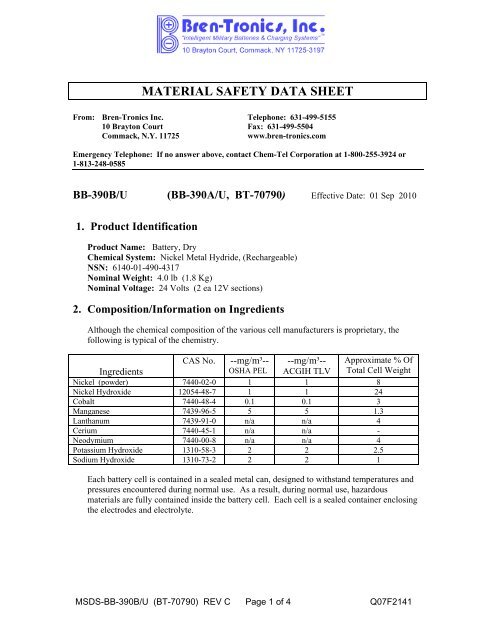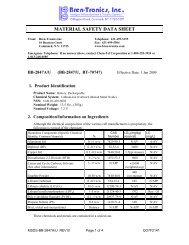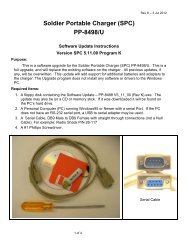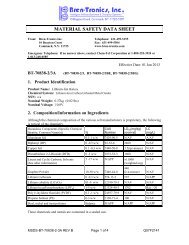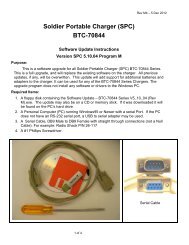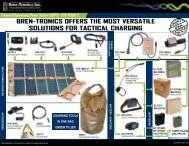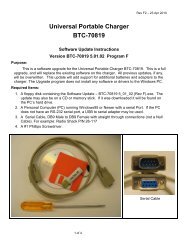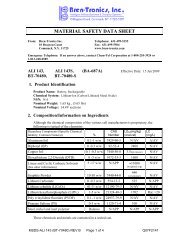Create successful ePaper yourself
Turn your PDF publications into a flip-book with our unique Google optimized e-Paper software.
MATERIAL SAFETY DATA SHEETFrom: <strong>Bren</strong>-<strong>Tronics</strong> <strong>Inc</strong>. Telephone: 631-499-515510 Brayton Court Fax: 631-499-5504Commack, N.Y. 11725www.bren-tronics.comEmergency Telephone: If no answer above, contact Chem-Tel Corporation at 1-800-255-3924 or1-813-248-0585BB-390B/U (BB-390A/U, BT-70790) Effective Date: 01 Sep 20101. Product IdentificationProduct Name: Battery, DryChemical System: Nickel Metal Hydride, (Rechargeable)NSN: 6140-01-490-4317Nominal Weight: 4.0 lb (1.8 Kg)Nominal Voltage: 24 Volts (2 ea 12V sections)2. Composition/Information on IngredientsAlthough the chemical composition of the various cell manufacturers is proprietary, thefollowing is typical of the chemistry.CAS No. --mg/m³-- --mg/m³-- Approximate % OfIngredientsOSHA PEL ACGIH TLV Total Cell WeightNickel (powder) 7440-02-0 1 1 8Nickel Hydroxide 12054-48-7 1 1 24Cobalt 7440-48-4 0.1 0.1 3Manganese 7439-96-5 5 5 1.3Lanthanum 7439-91-0 n/a n/a 4Cerium 7440-45-1 n/a n/a -Neodymium 7440-00-8 n/a n/a 4Potassium Hydroxide 1310-58-3 2 2 2.5Sodium Hydroxide 1310-73-2 2 2 1Each battery cell is contained in a sealed metal can, designed to withstand temperatures andpressures encountered during normal use. As a result, during normal use, hazardousmaterials are fully contained inside the battery cell. Each cell is a sealed container enclosingthe electrodes and electrolyte.<strong>MSDS</strong>-BB-390B/U (BT-70790) REV C Page 1 of 4 Q07F2141
3. Hazards IdentificationRoutes of Entry:Inhalation? Not during normal usage. If cell case is breached from extremeheat/pressure, exposure to ingredients could occur.Skin? Same. Electrolyte contact could cause caustic burn.Ingestion? NoPotential Health Effects:Chronic exposure to nickel may result in cancer, dermal contact may result in dermatitisin sensitive individuals. Cobalt has been identified as a 2B carcinogen.Signs/Symptoms of Exposure:N/A4. First Aid MeasuresEmergency & First Aid Procedures:If leakage from cell contacts: Skin – flush with water; wash with soap and water. Ifirritation persists, contact physician. Eyes – immediately flush with copious amounts ofwater for 15 minutes, then see physician at once.Respiratory Protection (Specify Type):As in any fire situation, use self-contained breathing apparatus, (SCBA)5. Fire Fighting MeasuresExtinguishing Media:Any class of extinguishing medium may be used on the batteries or their packingmaterial.Special Fire Fighting Procedures:Fire fighters should use self-contained breathing apparatus when a large number of cellsare involved.Unusual Fire and Explosion Hazards:May burst when subject to extreme heat.6. Accidental Release MeasuresVentilation:Not required under normal use.Protective Gloves:When handling leaking or open batteries.Eye Protection:Wear safety glasses with side shields if handling a leaking battery.7. Handling and StoragePrecautions to be taken in Handling and Storage:Accidental short circuit could bring high temperature elevation to the battery and willshorten the battery life. Ni-MH batteries have internal short circuit protection, butcondition should still be avoided. Any resulting heat can burn attendant skin and evenrupture the battery cell case.<strong>MSDS</strong>-BB-390B/U (BT-70790) REV C Page 2 of 4 Q07F2141
Other Precautions:Avoid incineration or mutilation. Use battery in proper equipment and observe properpolarity. Use only proper chargers for NiCd and NiMH batteries. Store in cool, dry place.8. Exposure Controls/Personal ProtectionSteps to be taken in Case Material is Released or Spilled:Avoid skin and eye contact. Collect all released material in a plastic bag for waste.9. Physical PropertiesAppearance:Rectangular shape10. Stability and ReactivityStability:StableConditions to Avoid:Do not heat or dissemble. Avoid heat, open flames, sparks and moisture.Hazardous Decomposition or By-products:Oxides of nickel.Hazardous Polymerization:Will not occur.Potential <strong>Inc</strong>ompatibilities:The battery cells are encased in a non-reactive container; however, if the container isbreached, avoid contact of internal battery components with acids, aldehydes andcarbonate compounds.11. Toxicological InformationCarcinogenicity: NTP? IARC Monograph? OSHA Regulated?Nickel yes - -Cobalt - 2B -12. Ecological InformationN/A13. Disposal ConsiderationsWaste Disposal Method:Do not incinerate. Dispose in accordance with local, state and federal regulations. Smallquantities may be allowed in household trash.<strong>MSDS</strong>-BB-390B/U (BT-70790) REV C Page 3 of 4 Q07F2141
14. Transport InformationDomestic Transportation within the U.S:These batteries, referred to as”Batteries, dry, sealed, n.o.s., (also known as Dry Batteries),are generally excepted from hazardous regulations provided they meet the requirementsof Special Provision 130 of US 49 CFR, which requires ALL BATTERIES MUST BEPACKED IN SUCH A WAY TO PREVENT SHORT CIRCUITS or the generation ofdangerous quantities of heat and be contained in ‘strong outer packaging’ that preventsspillage of contents.Batteries with a voltage exceeding 9 Volts and transported by aircraft must have thewords “not restricted” marked on each package or on a transport document such as an airwaybill accompanying the shipment.International Transportation:These batteries, referred to as”Batteries, electric storage, (also known as Dry Batteries),are generally excepted from hazardous regulations provided they meet the requirementsof Special Provision A123 of IATA DGR and ICAO TI, which requires ALLBATTERIES MUST BE PACKED IN SUCH A WAY TO PREVENT SHORTCIRCUITS or the generation of dangerous quantities of heat.(Additionally refer toIMDG 295-304, and ADR 295-304, 598).The IATA / ICAO regulations require the words “Not Restricted” and “Special ProvisionA123” to appear on the air waybill, when an air waybill is used.UN-DOT Hazardous Class:N/AUN ID NO:N/A15. Other InformationCharging:This battery is designed for recharging. A loss of voltage and capacity of batteries due toself-discharging during prolonged storage is unavoidable. Charge battery before use.Observe the specified charge rate since higher rates can cause a rise in internal gaspressure which may result in damaging heat generation or cell rupture and or venting.This information and recommendations set forth are made in good faith and believed to beaccurate as of the date of preparation. <strong>Bren</strong>-<strong>Tronics</strong> <strong>Inc</strong>. makes no warranty, expressed orimplied, regarding the accuracy of the data or the results to be obtained from the use thereof.<strong>MSDS</strong>-BB-390B/U (BT-70790) REV C Page 4 of 4 Q07F2141


